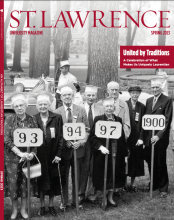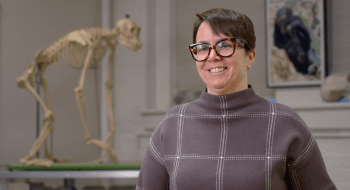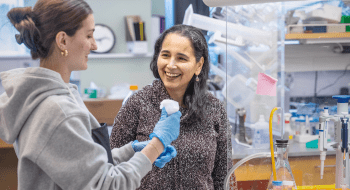
Creating Classrooms that Connect
In Bewkes Hall, St. Lawrence has created its first technology enabled classroom that empowers professors and students to collaborate on research, real-time calculations, and analysis.
Collaboration is key to tackling complex challenges in mathematics, data science, finance and economics, computer science, statistics, and other scientific fields. To facilitate this kind of connected work, the University is investing in tech-enabled classrooms like its first in Bewkes Hall, where faculty and students can project coursework and data from their computers onto walls and large monitors so everyone can explore, analyze, and debate complex issues together in real time.
“The renovations to Bewkes 107 reflect the increasingly engaging, group-based, and hands-on coursework that’s happening on campus,” says Michael Schuckers, the Charles A Dana Professor of Statistics and Chair of the St. Lawrence Math, Computer Science, and Statistics Department.
This is called multimodal education—in-person instruction that uses text, data, audio, video, and other materials to enrich learning. “In data-heavy, tech-driven disciplines, there is a need for classrooms that can facilitate this more inclusive and collaborative type of instruction,” Schuckers explains. And by emulating professional workspaces, these tech-enabled classrooms engage students and help them gain the confidence to rise into leadership positions after graduation.
To support an environment of streamlined connectivity, Bewkes 107 has several projectors and screens that give professors and students the opportunity to present information and work on projects together. The room also has several tables and chairs—all of them on wheels, allowing students and faculty to quickly customize the space so it works best for each class.
“It’s a collaborative atmosphere,” Schuckers says, “optimized for scientific analysis of massive amounts of data, like information captured by climate researchers or performance statistics of a sports team or an entire league.”
The renovations and technological improvements in the classroom were made possible with a donation from an anonymous set of parents to assist the expansion of the University’s new data science major.
Now faculty from the Mathematics, Computer Science, and Statistics department are adapting their instruction to take advantage of all the classroom has to offer.
Associate Professor Lisa Torrey is teaching Algorithm Analysis in Bewkes 107. In this upper-level computer science course, she has noticed students making the most of the room’s technology and flexibility.
“We can project our work, slides, and other info onto three of the room’s four walls,” she says. “Students are engaged because they can easily move tables and chairs to situate themselves and clearly see the material we’re discussing. In classrooms with one or two screens, there is usually someone who can’t see some of the screens. This has never happened in the renovated [or multimodal] Bewkes space.”
Her students are also able to do something simple, but rare:
“This course requires work to be done on paper and on laptops,” Torrey says. “Once students get situated, which only takes a moment, they’re able to have both their computers and paper notebooks in front of them. This makes it easier to learn and collaborate with each other. They’re working independently and in groups, reinforcing course material. This is active learning and it’s happening organically in this space.”




